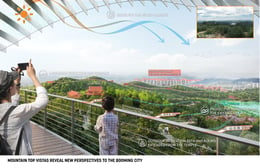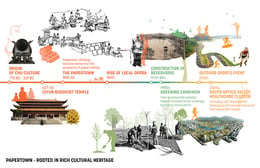Login
Registered users

Wuhan is a city known for its booming innovation economy and being situated amongst “one thousand lakes” in a flat riverplain. The Papertown Mountains—a long-neglected area surrounding the historic Papertown on the periphery of Wuhan—has been identified as the new city gateway and the last jewel to complete Wuhan’s ambitious “green necklace”, calling for a new vision of an accessible, inclusive, and engaging urban mountain park while restoring the degraded ecology and habitat.
The historical Papertown and its surrounding mountains are full of art and cultural heritages awaiting rediscovery. Papertown’s rich history dates back to 770 BC and was known for the arts of paper-making fostered by the growing Buddhism in central China. As Wuhan is rapidly growing as one of the innovation hubs in China, it is imperative to re-examine the potential of this urban mountain. The master plan creates a vision to transform Papertown Mountains Park (PMP) into a cultural, ecological, and recreational destination and to foster innovation and redevelopment of the villages and post-industrial land along the foothills.
The iterative planning process ensures a master plan that balances ecological restoration, regional stormwater management, recreational programs, and strategic urban infill development. A thorough multi-criteria analysis identified the most ecologically vulnerable locations as restoration priorities. Through managed forest succession, 24 square kilometers of diverse and complex forest will function as a substantial carbon sink for the rapidly growing city.
The park will also benefit the city’s expansive hydrological network. The water-sensitive planning strategies are made visible to the public via environmental signage as a means of educating visitors about how each part of the landscape plays an integral role in the regional ecosystem.
Even though the city has positioned Papertown Mountains as an urban forest park, it currently lacks accessibility, amenities, and ecological value. The mountains consist of fragmented monoculture woodlands and shrinking villages and are scarred with disserted quarry sites visible from miles away.
The masterplan strives to balance ecological restoration, regional stormwater management, recreational programs, and strategic urban infill development.
One of the most significant interventions of the master plan is a 150 miles long extensive trail system that reconfigures and connects the currently fragmented trails, accommodating a full range of outdoor activities, from competitive mountain biking to back-country hiking.
Multiple abandoned quarries offer opportunities for unique outdoor programs and trail connections on heavily disturbed sites. Coupled with ecological restoration, these sites become sculpture parks and extreme sports parks, acknowledging the site’s mining history and helping reactivate the PMP’s urban frontage.
Strategic infill developments along the foothills further stitch together the urban fabric between the park and the historical town, long divided by physical and visual barriers such as the railways.
The existing villages in the mountains suffer from a declining population. Surgical community redevelopment helps promote tourism, urban retreats, and environmental education, attracting visitors as well as promoting a service-based local economy.
Exploring the Papertown Mountains Park on foot, bike, or on a shuttle, people will come to appreciate the restored ecology and rich culture that proudly manifests the long history of our city. Once atop the new mountain park, visitors and Wuhan residents will discover new perspectives of this booming city and its burgeoning skyline.






















For 70 years, Sasaki has pioneered interdisciplinary design by integrating architecture, interior design, planning and urban design, space planning, landscape architecture, civil engineering, and ecology to shape the places around the globe. Out of Boston, Denver, New York City, and Shanghai offices, Sasaki is a diverse practice of over 350 professionals who share a singular passion for creating authentic, equitable, and inspiring places. Sasaki’s work has been recognized by over 900 major design awards. Sasaki is the only firm in the world that has won the prestigious Best Firm of the Year awards from both ASLA and APA.